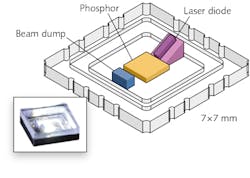Laser Lighting: White-light lasers challenge LEDs in directional lighting applications
Legacy halogen and metal halide light sources can produce highly directional beams, but with low efficiency and short lifetimes. And while light-emitting diodes (LEDs) are highly efficient with longer life, divergence angles <10° are difficult to produce from compact LED luminaires. Engineers at SoraaLaser (Goleta, CA) have found a solution by developing the first commercial solid-state, highly directional, and efficient white-light laser source with a luminance up to 100X better than LED luminaire devices.1
Using semipolar gallium nitride (GaN) laser diodes and phosphors, SoraaLaser has produced white-light surface-mount devices (SMDs) that produce up to 500 lumens of output from a 300 μm emitting area and enable collimated beam angles as low as 1-2° from compact optics.
Diode-pumped phosphor
To produce these white-light laser SMDs and luminaires, a high-power blue indium gallium nitride (InGaN) semipolar laser diode excites a very small remote phosphor target (<300 μm diameter) that converts the laser light to eye-safe, broad-spectrum, incoherent white light (see figure). Highly directional light with less than 2° of divergence from a 1-in.-diameter optic is possible.
Compared to laser diodes with a c-plane orientation, semipolar GaN devices have a 3-5X higher gain, as the semipolar orientation eliminates internal electrostatic fields and provides maximum overlap between electrons and holes. Semipolar blue laser diodes with outputs of 3 to 5 W are used as the engine for the resultant SMD. And unlike LEDs, laser diodes do not suffer from droop—the drastic reduction in efficiency that occurs with higher and higher drive currents because of Auger recombination.
The 7 × 7 mm SMD package consists of the blue laser-diode chip illuminating only a 300 μm area of the 1 × 1 mm phosphor in a reflective configuration, with a beam dump that blocks any blue light that could reflect from the single-crystal phosphor. The beam dump is essentially a passive absorbing element to improve product safety.
To harness the 1000 candela/mm2 from the Lambertian emission of 120° full-width half-maximum (FWHM) of a single 7 mm2 SMD, 1-2 in. collimating optics are used, producing a luminaire with 1/10 the beam angle of an LED-based luminaire of the same size and lumen output. In other configurations, this technology enables luminaires with 1/10 the diameter of LEDs, with 100X the lumen output of a typical LED.
Comparing efficiency
Even though the efficiency (lumens per electrical watt) of laser diodes (30-40%) is less than that of LEDs (50-60%), the key metric in directional lighting applications is the lumens per target area per watt of power consumption. For this metric, laser-diode illumination excels at ranges of 5 m or more and improves dramatically beyond 10 m compared to LEDs. As efficiency continues to improve for laser diodes, this gap will continue to shrink.
"White-light laser illumination technology is being commercialized in directional applications such as specialty lighting and automotive lighting," said Paul Rudy, SoraaLaser co-founder and senior vice president of marketing. "Beyond that, development is already ongoing to integrate directional white-light laser sources into next-generation lighting applications such as smart lighting, LiFi [light-based wireless data transmission], and IoT [Internet of Things]."
REFERENCE
1. J. W. Raring et al., "Laser diode phosphor modules for unprecedented SSL optical control," 2016 Illuminating Engineering Society (IES) Annual Conference, Orlando, FL (Oct. 24, 2016).
About the Author

Gail Overton
Senior Editor (2004-2020)
Gail has more than 30 years of engineering, marketing, product management, and editorial experience in the photonics and optical communications industry. Before joining the staff at Laser Focus World in 2004, she held many product management and product marketing roles in the fiber-optics industry, most notably at Hughes (El Segundo, CA), GTE Labs (Waltham, MA), Corning (Corning, NY), Photon Kinetics (Beaverton, OR), and Newport Corporation (Irvine, CA). During her marketing career, Gail published articles in WDM Solutions and Sensors magazine and traveled internationally to conduct product and sales training. Gail received her BS degree in physics, with an emphasis in optics, from San Diego State University in San Diego, CA in May 1986.
